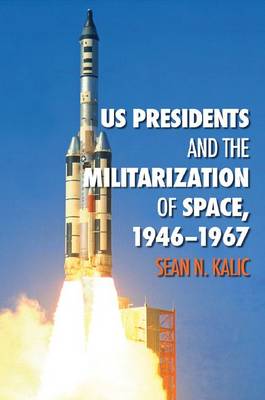In the clash of ideologies represented by the Cold War, even the heavens were not immune to militarization. Satellites and space programs became critical elements among the national security objectives of both the United States and the Soviet Union.
According toUSPresidents and the Militarization of Space, 1946-1967, three American presidents in succession shared a fundamental objective of preserving space as a weapons-free frontier for the benefit of all humanity. Between 1953 and 1967 Presidents Eisenhower, Kennedy, and Johnson all saw nonaggressive military satellite development, as well as the civilian space program, as means to favorably shape the international community's opinion of the scientific, technological, and military capabilities of the United States. Sean N. Kalic's reinterpretation of the development of US space policy, based on documents declassified in the past decade, demonstrates that a single vision for the appropriate uses of space characterized American strategies across parties and administrations during this period.
Significantly, Kalic's findings contradict the popular opinion that the United States sought to weaponize space and calls into question the traditional interpretation of the space race as a simple action/reaction paradigm. Indeed, beyond serving as a symbol and ambassador of US technological capability, its satellite program provided the United States with advanced, nonaggressive military intelligence-gathering platforms that proved critical in assessing the strategic nuclear balance between the United States and the Soviet Union. It also aided the three administrations in countering the Soviet Union's increasing international prestige after its series of space firsts, beginning with the launch of Sputnik in 1957.
|In the clash of ideologies represented by the Cold War, even the heavens were not immune to militarization. Satellites and space programs became critical elements among the national security objectives of both the United States and the Soviet Union.
According toUSPresidents and the Militarization of Space, 1946-1967, three American presidents in succession shared a fundamental objective of preserving space as a weapons-free frontier for the benefit of all humanity. Between 1953 and 1967 Presidents Eisenhower, Kennedy, and Johnson all saw nonaggressive military satellite development, as well as the civilian space program, as means to favorably shape the international community's opinion of the scientific, technological, and military capabilities of the United States. Sean N. Kalic's reinterpretation of the development of US space policy, based on documents declassified in the past decade, demonstrates that a single vision for the appropriate uses of space characterized American strategies across parties and administrations during this period.
Significantly, Kalic's findings contradict the popular opinion that the United States sought to weaponize space and calls into question the traditional interpretation of the space race as a simple action/reaction paradigm. Indeed, beyond serving as a symbol and ambassador of US technological capability, its satellite program provided the United States with advanced, nonaggressive military intelligence-gathering platforms that proved critical in assessing the strategic nuclear balance between the United States and the Soviet Union. It also aided the three administrations in countering the Soviet Union's increasing international prestige after its series of space firsts, beginning with the launch of Sputnik in 1957.
- ISBN13 9781603446914
- Publish Date 10 April 2012
- Publish Status Active
- Publish Country US
- Imprint Texas A & M University Press
- Format Hardcover
- Pages 224
- Language English
